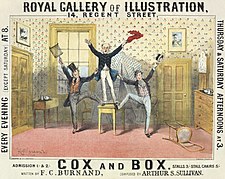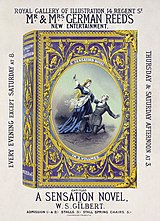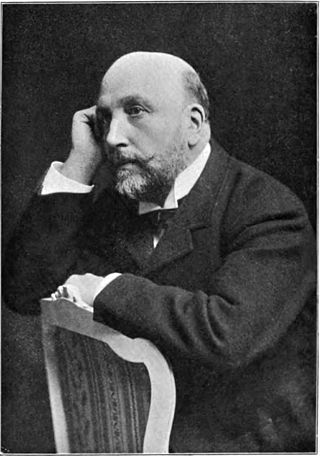
Sir Alexander Campbell Mackenzie KCVO was a Scottish composer, conductor and teacher best known for his oratorios, violin and piano pieces, Scottish folk music and works for the stage.

Sir Francis Cowley Burnand, usually known as F. C. Burnand, was an English comic writer and prolific playwright, best known today as the librettist of Arthur Sullivan's opera Cox and Box.

Cox and Box; or, The Long-Lost Brothers, is a one-act comic opera with a libretto by F. C. Burnand and music by Arthur Sullivan, based on the 1847 farce Box and Cox by John Maddison Morton. It was Sullivan's first successful comic opera. The story concerns a landlord who lets a room to two lodgers, one who works at night and one who works during the day. When one of them has the day off, they meet each other in the room and tempers flare. Sullivan wrote this piece five years before his first opera with W. S. Gilbert, Thespis.
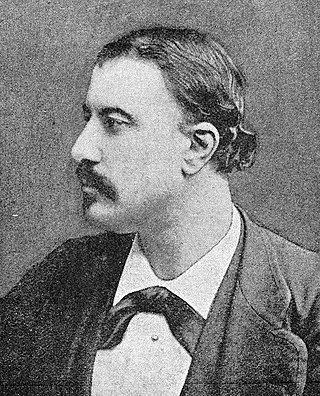
Frederic Emes Clay was an English composer known principally for songs and his music written for the stage. Although from a musical family, for 16 years Clay made his living as a civil servant in HM Treasury, composing in his spare time, until a legacy in 1873 enabled him to become a full-time composer. He had his first big stage success with Ages Ago (1869), a short comic opera with a libretto by W. S. Gilbert, for the small Gallery of Illustration; it ran well and was repeatedly revived. Clay, a great friend of his fellow composer Arthur Sullivan, introduced the latter to Gilbert, leading to the Gilbert and Sullivan partnership.

The German Reed Entertainments were founded in 1855 and operated by Thomas German Reed (1817–1888) together with his wife, Priscilla German Reed (1818–1895). At a time when the theatre in London was seen as a disreputable place, the German Reed family provided family-friendly entertainments for forty years, showing that respectable theatre could be popular.
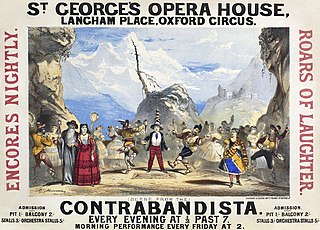
The Contrabandista, or The Law of the Ladrones, is a two-act comic opera by Arthur Sullivan and F. C. Burnand. It premiered at St. George's Hall, in London, on 18 December 1867 under the management of Thomas German Reed, for a run of 72 performances. There were brief revivals in Manchester in 1874 and America in 1880. In 1894, it was revised into a new opera, The Chieftain, with a completely different second act.

A Sensation Novel is a comic musical play in three acts written by the dramatist W. S. Gilbert, with music composed by Thomas German Reed. It was first performed on 31 January 1871 at the Royal Gallery of Illustration. Only four of German Reed's songs survive. Nearly 25 years later, the music was rewritten and published by Florian Pascal. The story concerns an author suffering from writer's block who finds that the characters in his novel are dissatisfied.
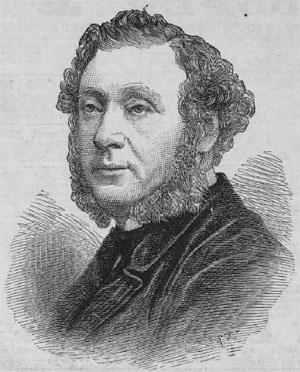
Thomas German Reed, known after 1844 as simply German Reed was an English composer, musical director, actor, singer and theatrical manager of the Victorian era. He was best known for creating the German Reed Entertainments, together with his actress wife, a genre of musical plays that made theatre-going respectable at a time when the stage was considered disreputable.

Ages Ago, sometimes stylised as Ages Ago! or Ages Ago!!, is a musical entertainment with a libretto by W. S. Gilbert and music by Frederic Clay that premiered on 22 November 1869 at the Royal Gallery of Illustration. It marked the beginning of a seven-year collaboration between Gilbert and Clay. The piece was a critical and popular success and was revived many times, including at St. George's Hall, London in 1870 and 1874, and in New York in 1880.

No Cards is a "musical piece in one act" for four characters, written by W. S. Gilbert, with music composed and arranged by Thomas German Reed. It was first produced at the Royal Gallery of Illustration, Lower Regent Street, London, under the management of German Reed, opening on 29 March 1869 and closing on 21 November 1869. The work is a domestic farce of mistaken identities and inept disguises, as two men desperately compete to marry a wealthy young lady. One is young and poor, and the other is a rich miser. Each disguises himself as her guardian.

Fanny Holland was an English singer and comic actress primarily known as the creator of principal soprano roles in numerous German Reed Entertainments.
This is a selected list of W. S. Gilbert's works, including all that have their own Wikipedia articles. For a complete list of Gilbert's dramatic works, see List of W. S. Gilbert dramatic works.

Our Island Home is a one-act musical entertainment with a libretto by W. S. Gilbert and music by Thomas German Reed that premiered on 20 June 1870 at the Royal Gallery of Illustration. The piece has five characters and is "biographical", in that the characters in the original production played themselves, except that they were given personalities opposite to their actual personalities.
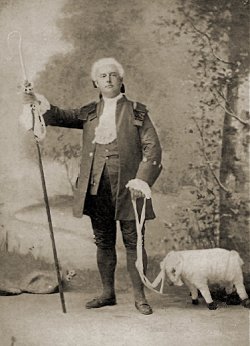
Happy Arcadia is a musical entertainment with a libretto by W. S. Gilbert and music originally by Frederic Clay that premiered on 28 October 1872 at the Royal Gallery of Illustration. It was one of four collaborations between Gilbert and Clay between 1869 and 1876. The music is lost. The piece is a satire on the genre of pastoral plays in which the characters, who each wish that they could be someone else, have their wish granted, with unhappy results.

Henry Brougham Farnie, often called H. B. Farnie, was a British librettist and adapter of French operettas and an author. Some of his English-language versions of operettas became record-setting hits on the London stage of the 1870s and 1880s, strongly competing with the Gilbert and Sullivan operas being played at the same time.

Priscilla Horton, later Priscilla German Reed, was an English singer and actress, known for her role as Ariel in W. C. Macready's production of The Tempest in 1838 and "fairy" burlesques at Covent Garden Theatre. Later, she was known, along with her husband, Thomas German Reed, for establishing and performing in the family-friendly German Reed Entertainments. There, she was a mentor to W. S. Gilbert, and her performances inspired Gilbert to create some of his famous contralto roles.

The Queen's Theatre was a London theatre established in 1867 on the site of St Martin's Hall, a large concert room that had opened in 1850. It stood on the corner of Long Acre and Endell Street, with entrances in Wilson Street and Long Acre. The site is within the modern Camden, part of Covent Garden.

Arthur Cecil Blunt, better known as Arthur Cecil, was an English actor, comedian, playwright and theatre manager. He is probably best remembered for playing the role of Box in the long-running production of Cox and Box, by Arthur Sullivan and F. C. Burnand, at the Royal Gallery of Illustration.

Richard Corney Grain, known by his stage name Corney Grain, was an entertainer and songwriter of the late Victorian era.

Thomas Grieve (1799–1882) was an English scene-painter.








